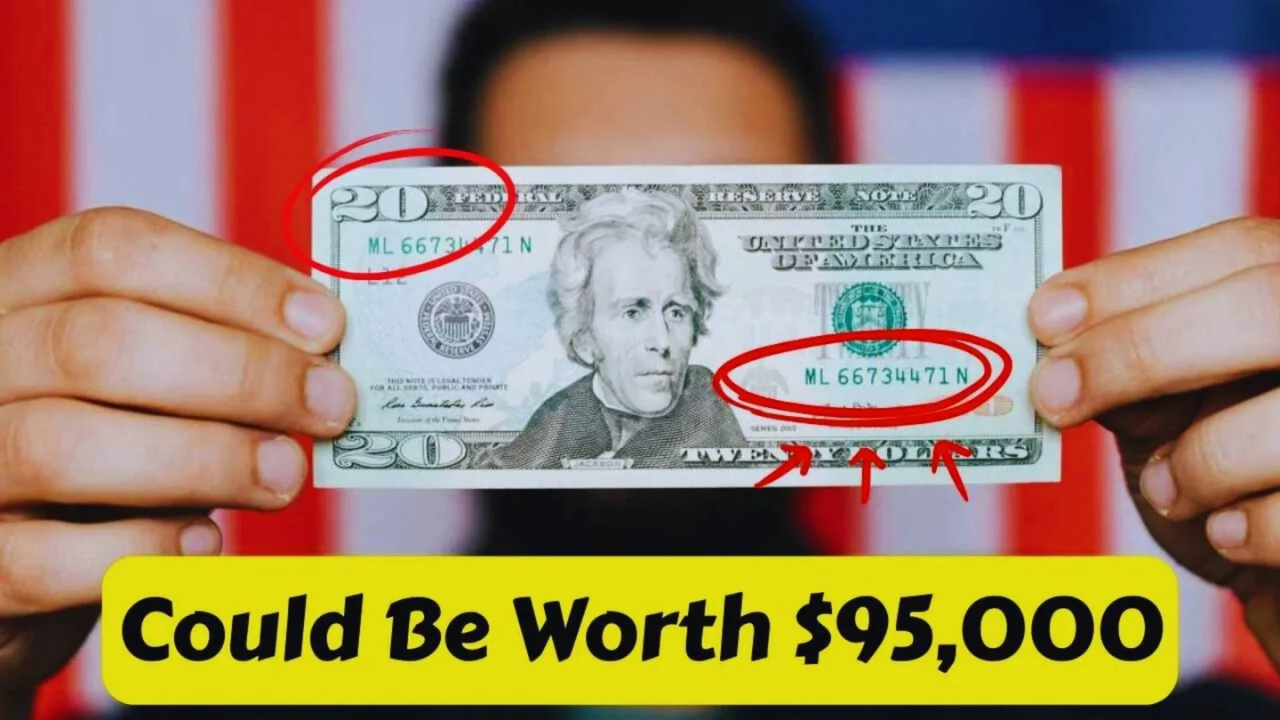$20 Bill Worth $95,000: Imagine using a $20 bill to buy lunch and later finding out it’s worth $95,000! Some rare $20 bills from 1996 with an upside-down Treasury seal are collector’s treasures. These printing mistakes slipped past the U.S. Mint’s checks, making them extremely valuable. As of August 2025, collectors are paying big money for these bills, and one could be hiding in your wallet. This article explains in simple words how to check your $20 bills, why they’re special, and what to do if you find one. Start looking today!
What is the 1996 $20 Bill Upside-Down Seal Error?
The 1996 $20 bill features President Andrew Jackson on the front and the White House on the back. Normally, the green Treasury seal on the right side of the bill is printed upright. In a rare mistake during a 1996 printing run at the U.S. Bureau of Engraving and Printing, some bills had this seal flipped 180 degrees, making it upside down. Only a tiny number of these error bills made it into circulation, making them a hot item for collectors.
Why Are These Bills So Valuable?
Collectors love these bills because the upside-down seal is a clear, dramatic error that’s super rare—less than 0.01% of U.S. bills have major mistakes like this. A pristine 1996 $20 bill with this error sold for $95,000 at auction in 2024, with even used ones fetching thousands. The value depends on the bill’s condition and unique serial numbers.
How to Check Your $20 Bill
You don’t need to be an expert to spot a valuable bill. Here’s how to check:
- Look for the Year: Find “Series 1996” on the front, usually near the bottom or top right.
- Check the Green Seal: The Treasury seal is on the right side. If it’s upside down (text and symbols flipped), you might have a winner.
- Compare with Another Bill: Hold it next to a regular $20 bill to confirm the seal is flipped.
- Inspect Condition: Crisp, uncirculated bills (no folds or tears) are worth more.
- Verify It’s Real: Check for security features like a watermark (Jackson’s face when held to light) or a security thread that glows green under UV light to rule out fakes.
| Feature to Check | What to Look For | Why It Matters |
|---|---|---|
| Series Year | “Series 1996” | Confirms the bill is from the error year |
| Treasury Seal | Green, upside-down (rotated 180°) | The rare error that drives value |
| Condition | Crisp, no creases or tears | Better condition = higher value |
| Security Features | Watermark, glowing security thread | Ensures the bill isn’t counterfeit |
| Serial Numbers | Unique patterns (e.g., 12344321) | Can boost value, especially radars |
Where to Find These Bills
You might find a 1996 $20 bill with an upside-down seal in:
- Pocket Change: Some are still used as regular money.
- Bank Cash: Ask for $20 bill packs from 1996 at your bank.
- Old Stashes: Check wallets, drawers, or jars from the 1990s.
- Cash Transactions: Look at bills from stores, flea markets, or ATMs.
What to Do If You Find One
If you think you’ve found a rare bill:
- Don’t Spend It: Treat it like a collectible, not cash.
- Store Safely: Use a plastic currency sleeve to protect it from damage.
- Get It Graded: Professional services like PMG (Paper Money Guaranty) or PCGS Currency can confirm its authenticity and value.
- Sell Smart: Options include:
- Online Auctions: eBay or Heritage Auctions for broad reach.
- Currency Dealers: Local coin shops or online dealers like APMEX.
- Collector Communities: Connect on Reddit’s r/currency or CoinCommunity.
Real-Life Examples
- 2024 Auction Record: A 1996 $20 bill with an upside-down seal sold for $95,000 in pristine condition.
- Circulated Bill Sale: A worn 1996 error bill fetched $5,000 in 2023 on eBay.
- Unique Serial Number: A 1996 bill with a radar serial number (like 12344321) sold for $10,000 in 2024.
Avoiding Scams
Beware of fake or altered bills. Check for proper paper texture, security threads, and clear printing. If the seal looks odd but other parts seem suspicious (blurry ink or wrong paper), get it checked by a professional. Only trust reputable graders like PMG or PCGS.
Conclusion
A 1996 $20 bill with an upside-down Treasury seal could turn your spare change into a fortune, with some worth up to $95,000. These rare printing errors are collector’s gold, and a few are still out there in wallets or cash registers. Check your $20 bills for the 1996 year and a flipped green seal, keep them in good shape, and get them appraised if they look special. You might be holding a treasure without knowing it. Start checking your cash now, and happy hunting!
FAQ
What makes a 1996 $20 bill with an upside-down seal valuable?
The rare printing error, where the green Treasury seal is flipped 180°, makes it scarce and desirable to collectors.
How do I check for the upside-down seal?
Look for “Series 1996” and a green seal on the right side that’s flipped compared to the rest of the bill. Compare it to a normal $20 bill.
Are these $20 bills still in circulation?
Yes, some 1996 error bills are still used as regular money, often found in change or old stashes.
What should I do if I find one?
Don’t spend it. Store it in a protective sleeve, get it graded by PMG or PCGS, and sell through auctions or dealers.
How much is a 1996 upside-down seal bill worth?
Depending on condition, it could be worth $1,000–$95,000, with uncirculated bills fetching the most.



